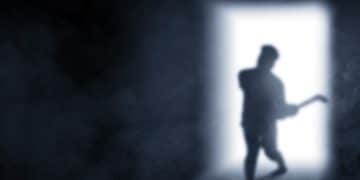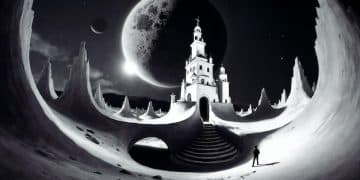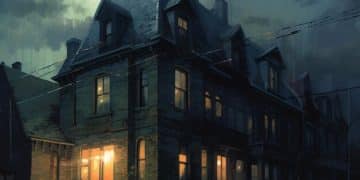Horror’s Evolution: From Gore to Psychological Terror in US Market
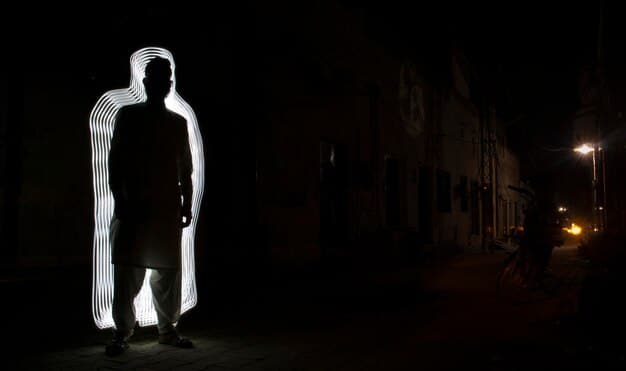
The evolution of horror in the US market reflects a profound shift, moving beyond overt gore to embrace the subtler, more unsettling depths of psychological terror, mirroring societal anxieties and cinematic innovation.
The landscape of fear in American cinema has undergone a dramatic transformation. What once delighted audiences with overt brutality and visceral shocks has metamorphosed into a genre that delves deep into the human psyche, exploring the most unsettling corners of our minds. This shift from explicit gore to psychological terror is not merely a stylistic change but a reflection of evolving cultural anxieties and sophisticated storytelling.
The Dawn of Horror: Early Shocks and Supernatural Fears
In its nascent stages, American horror often leaned into the supernatural and the grotesque, albeit through a nascent lens. Early films, constrained by nascent technology and moral codes, found their scares in the unseen, the monstrous, and the decidedly uncanny. The goal was often immediate, visceral reaction, delivered through implied threats and nascent special effects.
The early 20th century saw the genre grappling with its identity. Universal Pictures, in particular, carved out a niche with its iconic monster movies, which, while focusing on physical threats, often contained underlying psychological elements. These creatures of the night embodied primal fears, though their terror was largely externalized.
Pioneering the Macabre
Filmmakers of the silent and early sound eras laid the groundwork for what horror would become. They experimented with atmosphere, lighting, and sound to evoke unease, proving that fear could be cultivated beyond just jump scares. These were the first tentative steps towards a more nuanced approach to frightening audiences.
- Universal Monsters: Icons like Frankenstein’s Monster, Dracula, and the Wolf Man offered tangible threats.
- German Expressionism’s Influence: Stylistic elements from European cinema filtered into American productions, adding visual unease.
- Early Psychological Undercurrents: Films like “The Cat and the Canary” hinted at mental distress alongside physical danger.
As the genre matured, so too did its methods. The audience’s understanding of what constituted “scary” began to evolve, moving beyond simple apparitions and into the realm of human depravity and the unknown within the self. This foundational period, though seemingly simplistic by today’s standards, was crucial in establishing the genre’s capabilities.
The Golden Age of Gore: Slasher Films and Visceral Impact
The 1970s and 80s ushered in an era where horror embraced explicit violence with unprecedented fervor. The slasher film rose to prominence, characterized by masked killers, teenage victims, and a relentless focus on graphic, often inventive, deaths. This period marked a distinct pivot towards the tangible, the shocking, and the undeniably visceral.
Films like “The Texas Chain Saw Massacre” (1974), “Halloween” (1978), and “Friday the 13th” (1980) became cultural touchstones. They capitalized on a primal fear of the unknown assailant and translated societal anxieties into tangible, bloody threats. The allure was often in the spectacle of violence itself, a macabre ballet of suspense and sudden, brutal moments.
Behind the Mask: The Anatomy of a Slasher
The success of the slasher genre lay in its formulaic yet effective structure. A seemingly unstoppable killer, isolated settings, and a cast of archetypal characters provided a canvas for escalating terror. The focus was less on why the violence occurred and more on the how, making the mechanics of fear central to the narrative.
- Iconic Killers: Michael Myers, Jason Voorhees, Freddy Krueger became household names.
- Practical Effects: The era’s practical effects pushed boundaries, creating shocking on-screen deaths.
- Moralistic Undertones: Often, the “sins” of the victims (sex, drugs) dictated their demise.
While often criticized for their explicit nature, these films undeniably pushed boundaries and captured a segment of the audience eager for raw, unfiltered scares. They cemented horror’s place as a genre capable of delivering intense, immediate thrills, even if it meant sacrificing deeper psychological exploration for overt shock value. This period, though characterized by its reliance on gore, unknowingly paved the way for films that would later subvert these tropes, forcing a deeper introspection.
Challenging the Senses: The Rise of Psychological Horror
As the slasher craze began to wane, a new wave of horror emerged, one that sought to terrify not through external wounds, but through internal turmoil. Psychological horror, while not entirely new, began to dominate, focusing on the fragility of the human mind, the unreliability of perception, and the terrors that fester within our own consciousness. This shift was marked by sophisticated narratives and a deeper engagement with character psychology.
Films such as “The Silence of the Lambs” (1991), “Jacob’s Ladder” (1990), and later “The Blair Witch Project” (1999) perfected the art of subtle dread. They showcased that the unseen, the implied, and the mentally unsettling could be far more disturbing than any amount of blood. The fear came from uncertainty, paranoia, and the slow unraveling of characters’ sanity.
The Unseen Monster: Fear of the Mind
Psychological horror thrives on ambiguity and the exploration of mental states. Dissociation, delusion, trauma, and repressed memories become the primary tools for generating terror. The monster is often metaphorical, residing within the protagonist’s mind or the very fabric of their reality, leading to a pervasive sense of dread rather than sudden shocks.
- Unreliable Narrators: Characters whose perceptions are called into question.
- Atmosphere Over Action: Emphasis on unsettling ambiance, sound design, and cinematography.
- Exploration of Trauma: Deep dives into the lingering effects of psychological wounds.
This reorientation of horror’s focus allowed for more complex storytelling and resonated with audiences seeking a different kind of thrill. It proved that fear could originate not just from what lurks in the shadows, but from the darkness that already exists within us. The genre began to mature, moving beyond sensationalism to explore richer, more disturbing themes.
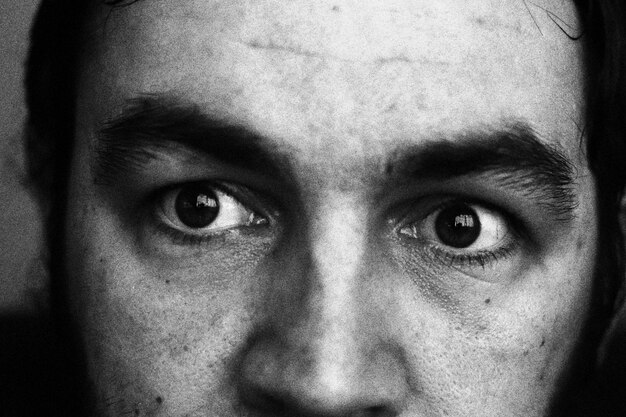
Societal Reflections: Horror as a Mirror of Modern Anxieties
Horror has always served as a dark mirror to society, reflecting collective fears and anxieties. The shift from gore-centric narratives to psychological terror is intrinsically linked to the evolving nature of these societal concerns. Where once the fear of physical harm was paramount, modern society grapples with more insidious threats: mental health crises, existential dread, the erosion of truth, and the unseen forces that manipulate our lives.
Contemporary psychological horror often taps into these deeper societal nerves. Films explore the anxieties surrounding technology (“Disconnect”), political polarization (“Get Out”), economic instability (“Parasite,” though not US-made, its influence is felt), and the subjective nature of reality itself (“Hereditary”). The monster is no longer just a physical entity but a manifestation of systemic issues or the breakdown of the individual within complex modern life.
From External Threats to Internal Unrest
The shift reflects a world where overt physical danger, while still present, is often overshadowed by the subtle, pervasive threats to our well-being and sanity. Psychological horror provides a safe space to grapple with these intangible fears, presenting them in heightened, allegorical forms.
- Anxiety and Depression: Themes of mental illness and breakdown are frequently explored.
- Existential Dread: Questions about purpose, meaning, and the human condition.
- Social Commentary: Subverting expectations to comment on race, class, and gender dynamics.
This genre’s ability to evolve with societal consciousness makes it particularly potent. It offers not just scares, but also a cathartic release and a framework for understanding the complexities of the modern world. By internalizing the terror, horror becomes a vehicle for deeper discussion and introspection, moving beyond simple entertainment to social critique.
Technological Innovation and Storytelling Nuance
The evolution of horror from overt gore to psychological terror has been significantly aided by advancements in filmmaking technology and a growing sophistication in narrative techniques. While practical effects once dominated the gore era, modern cinema leverages CGI, advanced sound design, and innovative cinematography to create nuanced, immersive psychological experiences.
The ability to manipulate perception through visual and auditory cues has become paramount. Subtle camera movements, disorienting soundscapes, and intricate editing can create a profound sense of unease without resorting to explicit violence. Filmmakers can now meticulously craft environments that reflect a character’s mental state, blur the lines between reality and delusion, and immerse the audience in a subjective, terrifying experience.
Crafting Fear: Tools of the Trade
Modern technology allows for precise control over the audience’s emotional response. Sound, in particular, has become a powerful tool, with advanced mixing techniques creating pervasive dread through low, unsettling frequencies or sudden, jarring noises. Visual effects, when used sparingly and effectively, can enhance the psychological impact rather than just showcase fantastical creatures.
- Immersive Soundscapes: Using silence, whispers, and distorted sounds to create tension.
- Subtle Visuals: Relying on shadows, reflections, and distorted perspectives.
- Advanced Editing: Non-linear narratives and rapid cuts to disorient the viewer.
Furthermore, the rise of streaming platforms has provided a fertile ground for experimental and character-driven horror, allowing filmmakers to explore complex psychological themes without the pressure of a wide theatrical release. This has fostered an environment where narrative complexity and emotional depth are prioritized, leading to a richer, more diverse spectrum of horror films that push intellectual boundaries as much as they do visceral ones. The synergy between technological prowess and storytelling ambition has undeniably shaped the current trajectory of US horror.
Key Directors and Films Shaping the Trend
The shift towards psychological horror isn’t accidental; it’s the result of visionary directors and groundbreaking films that dared to challenge conventions. Luminaries like Stanley Kubrick with “The Shining” laid early groundwork, showing how a confined space and a descent into madness could be terrifying. His meticulous attention to detail and ability to evoke immense dread through atmosphere set a high bar for the genre.
In more recent times, directors such as Ari Aster (“Hereditary,” “Midsommar”) and Robert Eggers (“The Witch,” “The Lighthouse”) have championed slow-burn, atmospheric psychological terror. Their films prioritize emotional depth, disturbing imagery, and complex character studies over jump scares. Jordan Peele (“Get Out,” “Us”) has masterfully combined psychological horror with sharp social commentary, demonstrating the genre’s capacity for profound thematic exploration.
Influential Works and Their Legacy
Each of these directors, and many others, have contributed to a vibrant tapestry of psychological horror that has redefined what audiences expect from the genre. Their films are often debated and analyzed, becoming part of the broader cultural conversation, indicating the genre’s growing intellectual standing. They don’t just scare; they provoke thought and linger long after the credits roll.
- “The Shining” (1980): A masterclass in psychological unraveling and isolation.
- “Get Out” (2017): Blended social horror with psychological body snatching.
- “Hereditary” (2018): Explored grief, trauma, and a family’s horrifying legacy.
These films, and the directors behind them, have solidified psychological horror’s place as a dominant force in the US market. They’ve proven that the most effective scares come not from what we see, but from what we *imagine* and what we *feel*, driving the genre towards a more introspective and intellectually stimulating future. Their influence is clear in the growing number of films that prioritize mental distress and atmospheric dread over overt violence.
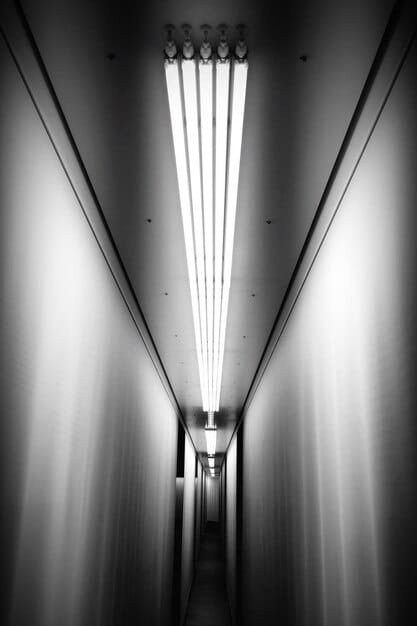
The Future of American Horror: Blurring the Lines
The trajectory of American horror suggests a continued blurring of lines between subgenres, and a further integration of psychological depth. While gore will likely never disappear entirely from the horror landscape, its role may continue to evolve, perhaps serving more as a punctuation mark for psychological concepts rather than the main event. Filmmakers are constantly experimenting, pushing boundaries, and finding new ways to tap into universal and specific fears.
We can anticipate a continued focus on thematic richness, exploring complex social issues, technological anxieties, and the ever-evolving nature of human consciousness. The genre’s adaptability ensures its longevity and relevance, as it continues to metamorphose to terrify audiences in ways that resonate with the current zeitgeist.
Emerging Trends and What’s Next
The future may hold even more hybrid forms, perhaps combining the visceral impact of earlier eras with the nuanced dread of psychological themes. The rise of interactive horror experiences and virtual reality also suggests new frontiers for immersive fear, potentially putting viewers directly into psychologically unsettling scenarios. The ultimate goal, as always, is to scare, but the methods are becoming increasingly sophisticated.
- Hybrid Genres: Combining elements of sci-fi, drama, and horror for complex narratives.
- Personalized Fear: Exploring niche anxieties and highly specific phobias.
- Interactive Experiences: New media pushing the boundaries of audience engagement.
Ultimately, the evolution of horror in the US market reflects not just cinematic trends, but a deeper understanding of what truly frightens us. As society changes, so too do its monsters, and the most compelling frights are often found within the intricate, unsettling labyrinth of the human mind. The genre continues to promise a terrifying yet fascinating journey into the unknown depths of fear.
| Key Aspect | Brief Description |
|---|---|
| 🔪 Gore Era | Focused on explicit violence, often in slasher films with iconic killers. |
| 🧠 Psychological Terror | Emphasizes mental distress, unreliable perception, and internal fears. |
| societal Reflection | Horror mirrors societal anxieties, from physical threats to mental health. |
| 🔮 Future Trends | Anticipate genre blurring and deeper thematic explorations with tech. |
Frequently Asked Questions About Horror’s Evolution
The shift was driven by evolving audience tastes, a desire for more sophisticated narratives, and societal changes. As viewers became desensitized to overt gore, filmmakers sought new ways to create fear by tapping into deeper, more internal anxieties like mental health issues, existential dread, and the complexities of human perception.
Yes, gore films continue to be made and have a dedicated audience. While psychological horror currently dominates critical acclaim, there’s a strong market for slasher, body horror, and extreme gore films. Many modern horror films also blend elements of gore with psychological themes, creating a more nuanced horrifying experience.
Technological advancements in sound design, cinematography, and visual effects enable filmmakers to create more immersive and disorienting experiences for psychological horror. Subtle camera work, unsettling soundscapes, and advanced editing techniques can manipulate perception and intensify dread far more effectively than ever before, enhancing the internal fears.
Several directors are instrumental in this shift. Stanley Kubrick’s “The Shining” remains a cornerstone. More recent examples include Ari Aster (“Hereditary”), Robert Eggers (“The Witch”), and Jordan Peele (“Get Out”). These filmmakers prioritize atmosphere, character study, and thematic depth over explicit on-screen violence.
Gore focuses on explicit, visceral violence and bodily harm, aiming for shock and revulsion. Psychological terror, conversely, targets the mind, creating fear through suspense, ambiguity, paranoia, and the exploration of mental instability. It often relies on implication, atmosphere, and the unraveling of a character’s (or viewer’s) perceptions rather than outright bloodshed.
Conclusion
The evolution of horror in the US market offers a fascinating lens through which to view societal anxieties and cinematic innovation. From the overt, often sensationalized scares of the gore era to the intricate, mind-bending dread of psychological terror, the genre has matured significantly. This transformation is not a rejection of its past but an expansion of its capabilities, demonstrating that the deepest fears often reside not in external threats, but within the complex, unsettling landscape of the human psyche. As filmmakers continue to innovate, the future of horror promises an ever more nuanced exploration of what truly terrifies us, constantly adapting to reflect the evolving fears of a modern world.
